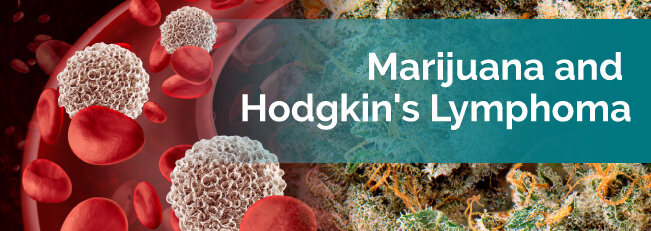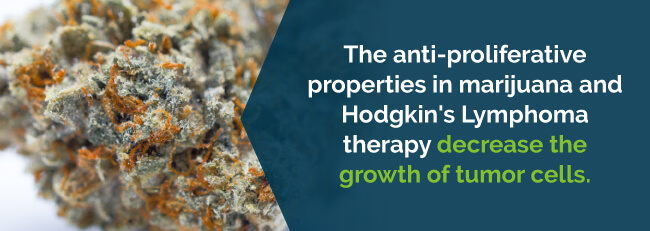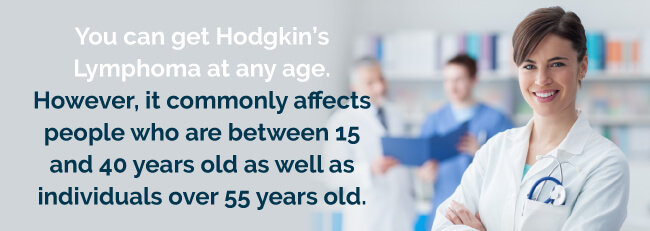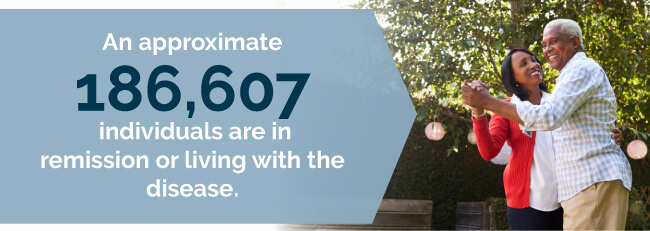
Chances are good you’ve already heard about medical marijuana and its powerful effect on many symptoms of various conditions. Cannabis can help with pain, promote weight gain, curb nausea and vomiting, assist with sleep, offer motivation and energy, boost your mood and rekindle social enjoyment.
Now there’s more good news: things are looking good for medical marijuana for Hodgkin’s Lymphoma, too.
Currently, there’s a lot of evidence suggesting that cannabinoids may kill cancer in human beings. And a growing number of patients for the past several years have reported that applying or consuming cannabis eliminates their cancer. In a laboratory setting, compounds in medical marijuana kill cancer cells through four primary mechanisms:
The anti-proliferative properties in marijuana and Hodgkin’s Lymphoma therapy decrease the growth of tumor cells. The anti-metastatic properties decrease the spreading of cancer. The anti-angiogenesis properties stop tumors from growing blood vessels, which they need to survive, and the anti-apoptosis properties kill the cancer cells.
Find A Doctor Find A Dispensary

Furthermore, not only does scientific research suggest cannabinoids kill cancer cells, but it also indicates your body is programmed for cannabinoids to take this action, since endocannabinoids kill cancer cells as well. Like anandamide, your body produces endocannabinoids. A couple of studies show this.
One study in June 2003 showed anandamide caused apoptosis in several prostate cancer cell lines. In February of 2006, another study found anandamide hindered breast cancer cells from spreading.
These scientific findings are hugely supportive of patients’ continuous reports of cancer remissions. Some terminally ill cancer patients have even reported going into remission after using cannabis oil treatment.
The Journal PLoS One published a new study that found marijuana for Hodgkin’s Lymphoma a successful treatment. Researchers at Martin-Luther-University, Leipzig University and Goethe University examined the delivery of CB1 protein in main HL cases for the study. They investigated the role of CB1 signals on cell survival using lymphoma-derived cell lines.

After conducting the study, the researchers concluded CB1 as a feature of Hodgkin’s Lymphoma and serves as a possible selective target in treating HL. And since medical marijuana serves as a natural and direct agonist to the cannabinoid receptors in our body, it could offer an optimal cancer treatment.
Medical cannabis for Hodgkin’s Lymphoma might help you in various ways. Below are some of the HL symptoms weed can help ease to improve your quality of life.
The medical pot plant seems to inspire a lot of laughter and smiles. According to mice research, the psychoactive THC compound in low doses may boost your mind in a way similar to how antidepressants work. The research found CBD is fast-acting and has a positive influence on your mind. Research on mice suggests CBD can benefit your mood after one dose rather than requiring several weeks, as many antidepressants do.
Pain is one of the most common side effects of chemotherapy. Some types of chemo drugs may even cause long-term neuropathy (pain), weakness and numbness from nerve damage and may reduce your quality of life after your treatment.
The discomfort and pain chemotherapy causes can interfere with your sleep drastically. However, cannabis and Hodgkin’s Lymphoma treatment helps you fall and stay asleep longer, according to research. Most particularly, marijuana extends the time you spend in the deep sleep stage or your restorative sleep stage. Getting an adequate amount of deep sleep is essential for lymphatic system health.
CBD and THC are two primary compounds in medical weed and are known antiemetics. Antiemetics are substances that relieve vomiting. Studies conducted in the 1970s revealed marijuana compounds reduce nausea effectively in patients who are receiving chemotherapy.
Other cannabinoid effects, according to the National Cancer Institute, include:
Cannabis for Hodgkin’s Lymphoma strains range from pure Indicas and pure Sativas to hybrid strains consisting of both Indica and Sativa.
Indica strains are successful in relieving overall pain. People who struggle with insomnia also commonly use them. It’s best to use your Indica strain treatment in the evening before you go to bed, since it can make you feel tired and sleepy.
Benefits of Indica:
Indica Strains for Hodgkin’s Lymphoma:
Sativa strains promote energy and creativity. Many patients who use Sativa strains report an energetic, uplifting and “cerebral” high that’s best suited to daytime use.
Benefits of Sativa:
Sativa Strains for Hodgkin’s Lymphoma:
If you’re looking for the best of both worlds, try these hybrid strains:
Contrary to thought, smoking is not your only way to receive your medical marijuana for Hodgkin’s Lymphoma. Both medical and recreational weed users have come up with a variety of ways for you to use cannabis. You’re sure to find a method that suits your preference. Some methods include:
Consult with your physician or talk with the professionals at your dispensary to determine which method is best for you. You might have to try various methods before you become comfortable with one in particular. Always start out with small doses and work up to larger doses, since cannabis can take a little while to affect you depending on the strain and method of use.
If you live in a state that has approved medical cannabis, your first step toward becoming a valid patient is to obtain a doctor’s authorization or recommendation. However, although a sound initial action, finding a doctor able to or even willing to recommend medical cannabis can take some research.
Thankfully, you can search for a medical marijuana doctor or dispensary all in one place on MarijuanaDoctors.com. You’ll get information on locations, hours, reviews and much more.
Find A Doctor Find A Dispensary
Hodgkin’s disease (HD) is a blood cancer and type of lymphoma that begins in your lymphatic system. Your lymphatic system eliminates waste and helps your immune system fight infections.
Hodgkin’s Lymphoma starts in your white blood cells, known as lymphocytes, protecting you from infections and germs. When you have HD, these lymphocytes grow abnormally and spread past your lymphatic system. Your body has a harder time fighting infections as the disease progresses.
Hodgkin’s Lymphoma may either be nodular lymphocytic predominant Hodgkin’s Lymphoma (NLPHL) or classic Hodgkin’s disease. The type you develop depends on the type of cells and their behavior you have in your condition.
The primary cause of the disease is unknown, but it’s associated with DNA changes or mutations and the Epstein-Barr virus (EBV) known to cause mononucleosis. You can get Hodgkin’s Lymphoma at any age. However, it commonly affects people who are between 15 and 40 years old as well as individuals over 55 years old.

There are two types of Hodgkin’s Lymphoma: Classical Hodgkin’s Lymphoma and Nodular Lymphocyte Predominant Type.
Classical Hodgkin’s Lymphoma
Classical Hodgkin’s Lymphoma has four subtypes. Each contains Reed-Sternberg cells or abnormal cells. These are B lymphocytes that have become cancerous. These include:
Nodular Lymphocyte Predominant Type
Only 10 percent of Hodgkin’s Lymphoma is nodular lymphocyte predominant type. Older people tend to get this type more than younger people.
The primary difference between this type of HL and classical HL is that Hodgkin’s has very few Reed-Sternberg cells. The cells it does have, doctors call popcorn cells.
When diagnosed, the nodular lymphocyte predominant type is usually only in a single lymph node group, meaning localized disease. It grows slower than classical HL and has a different treatment.
The disease is named after Thomas Hodgkin. In 1832, he was the first to describe abnormalities in the lymphatic system. But he did note Marcello Malpighi gave the earliest description of HL in 1666.
In 1894, treatment developed for the disease. The treatment was an arsenic-laced medication. Chevalier and Bernard, in 1932, described radiation therapy used to treat HL, primarily for palliative use. In the mid-forties, radiation therapy began to prove a successful treatment for the disease. MOMP, which is a combination of chemotherapy agents, was developed in 1963 and consisted of vincristine, cyclophosphamide, prednisone and methotrexate. The drug regimen EBVP became available in 1987 and consisted of bleomycin, epirubicin, prednisone and vinblastine.
The German Hodgkin’s Study Group devised the BEACOPP regimen in 1992, which consisted of seven chemotherapy agents.
The five-year survival rate for Hodgkin’s Lymphoma patients has more than doubled. It went from 40 percentin whites from 1960 to 1963 to 88.5 percent from 2006 to 2012 for all races.

Lymph node swelling is the most common HL symptom. You’ll have a painless lump formed under your skin in one or more of these areas of your body:
Other HL symptoms may include:
If you’re experiencing any of these symptoms, you should call your doctor immediately. Since they may also be symptoms of other conditions, you’ll need to get an accurate diagnosis only your doctor can provide.
Along with physical symptoms, living with HL can significantly impact your emotions.
While you’re waiting for consultations and appointments, which is a huge part of living with HL before and after your treatment, it can lead you to have challenging and difficult emotions. You may be unsettled while waiting for test results. Not knowing what to expect, being anxious about the results and even having to wait weeks for the results can trigger anxiety.
No matter what condition you receive a diagnosis for, anxiety is normal. Even after treatment, you’ll likely still be anxious. You may worry about your Hodgkin’s Lymphoma coming back or relapsing. You may find yourself more watchful of pains, aches and other bodily feelings. Follow-up appointments can make you anxious if you’re not sure what to expect. You may feel uncertain about your life and constantly seek reassurance.
Treatment could significantly impact your mental well-being. While you may feel some relief starting treatment, you may still have some difficulty coping emotionally with this new reality. The treatment itself can cause certain side effects you’ll have to deal with and can change your current lifestyle and your relationships with others.
Feelings of anxiety and sadness are natural. Many people will deal with these feelings from time to time and you’re not alone if you feel this way. But when you feel this way most of the time, it could be a sign of depression.
It wouldn’t be “unnatural” to experience depression when you’re living with HL. You can’t just “pull yourself together” or “shake it off” when living with this disease. However, this doesn’t mean you’re weak, either. There are support systems in place that can help if you’re experiencing depression.
While people go through depression in their own ways, you may have depression if you feel:
If you’ve struggled with depression before, you’ll likely experience it again after receiving a lymphoma diagnosis.
The American Cancer Society’s estimates for 2017 reveal:
According to estimates from the Leukemia & Lymphoma Society:

Current Treatments Available for Hodgkin’s Lymphoma and Their Side Effects
Many people with Hodgkin’s Lymphoma look forward to recovery and feel they can move ahead once they begin treatment. Since HL is among the most curable types of cancer, this may come as no surprise.
There are several approaches doctors take when treating Hodgkin’s Lymphoma, depending on their stage.
With chemo, the doctor gives you certain toxic medications potent enough to kill lymphoma cells. But they can also harm your healthy cells as well and cause unwanted side effects. Chemo is a standard treatment in HL, which typically involves more than one drug administered through an IV or peripheral intravenous line.
Some side effects of chemo may include:
Radiotherapy uses special devices that create high-energy rays to target and kill HL cells. Doctors have been using radiation therapy for a long time in patients who are in the earlier stages of HL. But since it does potentially produce long-term toxic effects, there’s been a change in this treatment approach. Now, radiotherapy mainly targets the lymph node areas the disease affects.
Some side effects of radiation therapy may include:
While not recommended as a first approach treatment in HL patients, stem cell transplants may cure a patient who has relapsed. There are two types of this method doctors use:
Some side effects of stem cell transplantation may include:
Clinical trials are another approach your doctor may suggest. Clinical trials may involve new medications, new combinations of drugs or new stem cell transplantation methods.